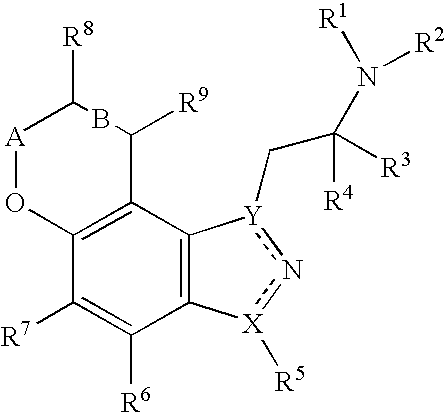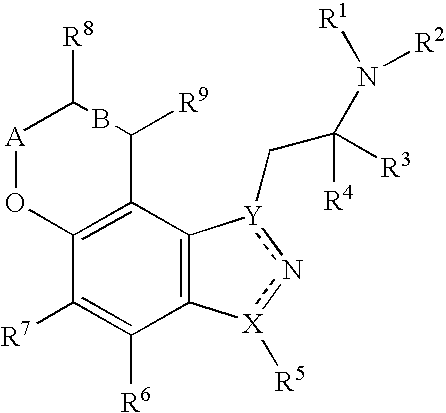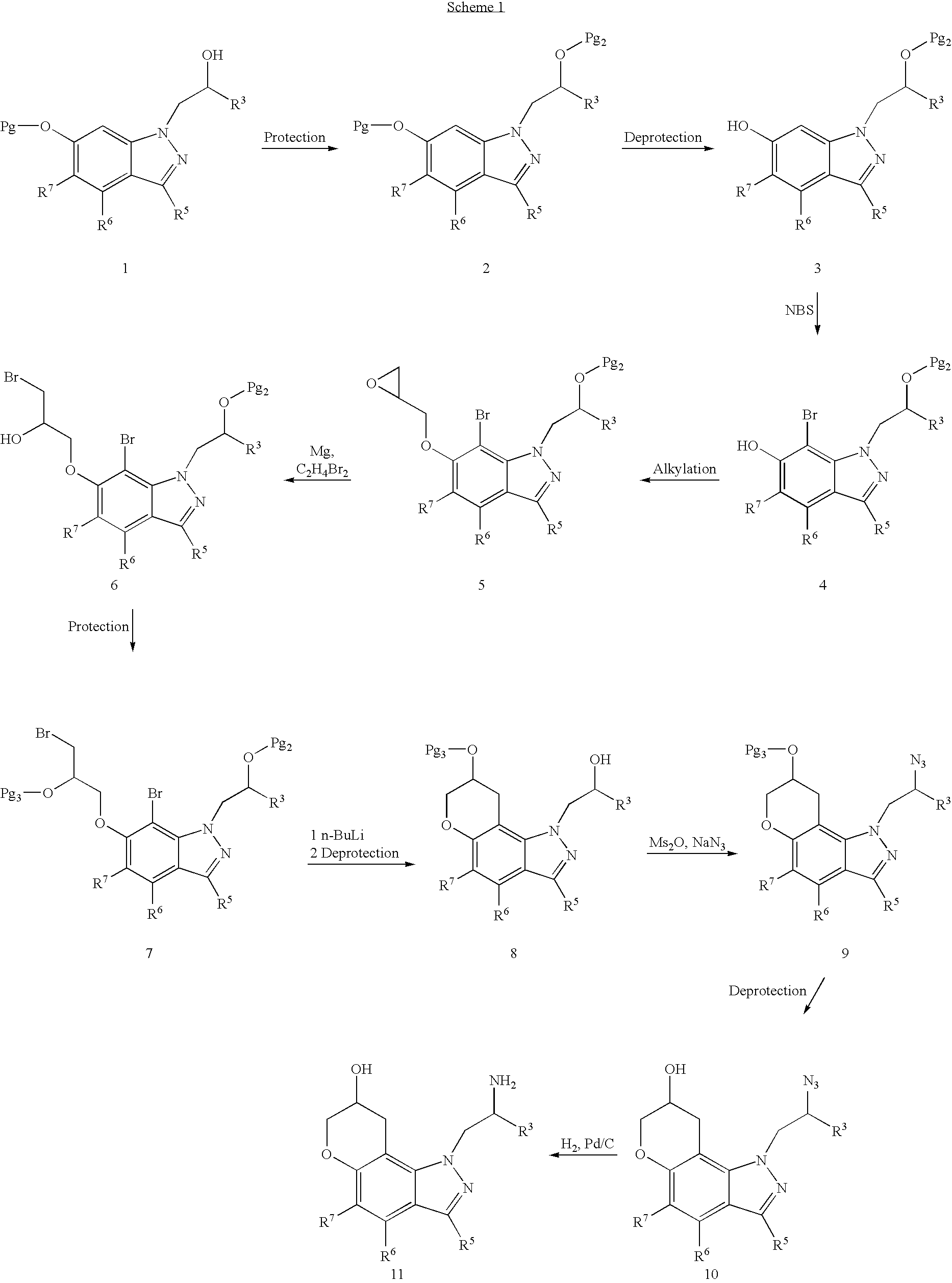Pyranoindazoles and their use for the treatment of glaucoma
a technology of pyranoidazoles and glaucoma, which is applied in the direction of biocide, drug composition, organic chemistry, etc., can solve the problems of individuals who do not respond well, considered to be at high risk for eventual development of visual loss, etc., and achieve the effects of treating glaucoma, reducing and controlling normal or elevated intraocular pressur
- Summary
- Abstract
- Description
- Claims
- Application Information
AI Technical Summary
Benefits of technology
Problems solved by technology
Method used
Image
Examples
preparation 1
1,7,8,9-Tetrahydro-pyrano[2,3-g]indazol-8-ol
Step A: 6-Allyloxy-1H-indazole
To a solution of 1H-indazol-6-ol (20.0 g, 150 mmol) in acetone (450 mL) was added pulverized potassium carbonate (22.4 g, 162 mmol), cesium carbonate (2.00 g, 5.7 mmol), and allyl iodide (14.63 mL, 160 mmol) and the mixture was stirred for 18 h at ambient temperature. Additional potassium carbonate (5.00 g, 36 mmol) and allyl iodide (1.4 mL, 15 mmol) were added and the mixture was stirred for 2 h followed filtration. Water (200 mL) was added to the filtrate and the volume of the mixture was reduced by about half in vacuo and extracted with dichloromethane (2.times.100 mL). The combined extracts were dried (MgSO.sub.4) and evaporated to a residue which was purified by chromatography (silica, 20% to 50% EtOAc / hexane) to give a yellow solid (14.7 g, 56%): mp 110-112.degree. C.; LC / MS (+APCI) m / z 175 (M+H). Unreacted starting material was recovered (4.71 g).
Step B: 7-Allyl-1H-indazol-6-ol
A solution of the product ...
preparation 2
1-(6-Benzyloxyindazol-1-yl)-propan-2-ol
Step A: (6-Benzyloxy-indol-1-yl)-propan-2-ol
To a stirred, cooled (10.degree. C.) suspension of sodium hydride (80.7 g of a 60% dispersion to in mineral oil, 2.02 mol) in anhydrous THF (1.9 L) was added a solution of 6-benzyloxyindole (375 g, 1.68 mol) in anhydrous THF (1.9 L) keeping the temperature below 25.degree. C. After 2 h at 10.degree. C., propylene oxide (140 mL, 2.0 mol) was added dropwise keeping the temperature below 25.degree. C. After 48 h at 10.degree. C., propylene oxide (71 mL, 1.0 mol) was added. After 96 h at 10.degree. C., saturated aqueous potassium dihydrogenphosphate (3.8 L) and ethyl acetate (3.8 L) were carefully added, the layers were separated and the aqueous solution was extracted with 3.8 L of ethyl acetate. The combined organic extracts were dried over sodium sulfate and concentrated in vacuo to yield a solid (520 g, 110%, contains mineral oil).
Step B: N-(5-Benzyloxy-2-formylphenyl)-N-(2-hydroxypropyl)-formamide
A so...
preparation 3
(R)-1-(6-Benzyloxyindazol-1-yl)-propan-2-ol
Step A: 4-Benzyloxy-2-fluorobenzonitrile
Benzyl bromide (467 mL, 3.93 mol) and potassium carbonate (1.4 kg, 10.1 mol) were added to a solution of 2-fluoro-4-hydroxybenzonitrile (490 g, 3.57 mol) in acetone (3.4 L). The stirred mixture was heated at 60.degree. C. for 20 h, then cooled and filtered. The filtrate was concentrated and the resulting solid was triturated with 10% ethyl acetate-hexane (5 L) and vacuum dried at 35.degree. C. to give the desired product (787 g, 97%).
Step B: 4-Benzyloxy-2-((R)-2-hydroxy-propylamino)benzonitrile
A solution of (R)-(-)-1-amino-propan-2-ol (389 g, 5.19 mol) in dimethyl sulfoxide (600 mL) was added to a solution of the product from Step A (786 g, 3.46 mol), basic alumina (786 g), and 4A molecular sieves (131 g). The stirred mixture was heated at 110-140.degree. C. for 24 h, cooled and filtered, the filter-aide was washed with 10 L of 4:1 ether-ethyl acetate followed by 4 L of 3:2 ethyl acetate-hexane. The o...
PUM
| Property | Measurement | Unit |
|---|---|---|
| volume | aaaaa | aaaaa |
| pH | aaaaa | aaaaa |
| temperature | aaaaa | aaaaa |
Abstract
Description
Claims
Application Information
 Login to View More
Login to View More - R&D
- Intellectual Property
- Life Sciences
- Materials
- Tech Scout
- Unparalleled Data Quality
- Higher Quality Content
- 60% Fewer Hallucinations
Browse by: Latest US Patents, China's latest patents, Technical Efficacy Thesaurus, Application Domain, Technology Topic, Popular Technical Reports.
© 2025 PatSnap. All rights reserved.Legal|Privacy policy|Modern Slavery Act Transparency Statement|Sitemap|About US| Contact US: help@patsnap.com



